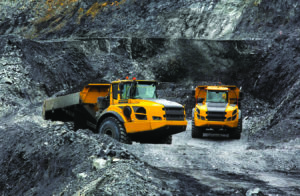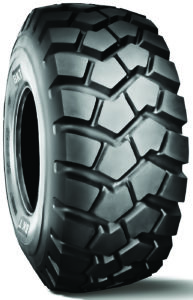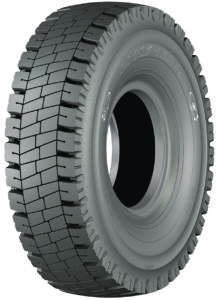
The Y67 IND-3 Low-Seam Mining Tires, in 29.5 R 25 and 750/65 R 25 sizes, are wider to accommodate heavier loads and high-torque equipment in confined, underground spaces. (Photo: Yokohama OHT)
Lowered costs, increased productivity and improved efficiency are among the benefits offered by the newest tires from the biggest suppliers
by jesse morton, technical writer
The latest generation of compound and tread design innovations are prominent features of the latest additions to established lines of tires offered by the biggest suppliers. Generally speaking, the compounds reportedly give dramatic improvements in longevity. The tread patterns offer improved machine control and operator comfort, and better durability in worse conditions.
The benefits offered combine to lower costs. And each new release speaks to a specific trend in demand.
For example, Yokohama OHT released a tire that is designed to help underground miners haul more coal. Co-developed in Appalachia, the tire is a response to the advent of newer machines with a lot more torque and that move a lot more coal compared to predecessor machines.
BKT recently released a new tire for articulated trucks. It is an addition to a longstanding line of popular mining tires widely renowned for ruggedness. Articulated trucks will undoubtedly be in use in expansion projects as both metals and coal see higher year-over-year prices due to inflation that won’t be ending anytime soon.
Michelin is releasing a new giant tire for rigid haul trucks. It features new compounds and will add to an established line that was purpose-designed to help customers improve productivity.
Goodyear released a new tire for stockyards and ports. For container handlers, reach stackers and shuttle sprinter carriers, the tire offers much-needed efficiency.
One thing these new tires also have in common is the suppliers hold back no superlatives when describing them. They say these tires represent their best work, and will help miners do theirs.
Low-Seam Mining Tires
Yokohama Off-Highway Tires America reported the Y67 IND-3 Low-Seam Mining Tires have the dimensions, compounds, tread patterns and proven track record to be ideal for a wide range of applications in underground coal. The tires can go on scoops, shuttle cars, utility vehicles and more.
The tires were initially developed in Appalachian coal to meet the specific needs of regional miners, Yokohama said. “Yokohama developed extra-wide Y67 underground mining tires to help the underground coal mining industry handle bigger loads and more powerful machinery than ever,” said Adam Turner, sales manager, Yokohama Off-Highway Tires America.
“The newer tires in the Y67 line, particularly the new 39×15-20 and our 15- to 20-in.-wide Y67 IND-3s, are significantly wider to accommodate growing loads of coal and high-torque equipment in the very confined space of the modern mine,” he said.
The tires were made for newer-model machines that can now haul more than 30 tons of coal. “Those shuttle cars, especially the electric ones, produce tremendous amounts of torque,” Turner said. “You can tell just by looking at one of the hubs with 20 bolts on it.”
Before the advent of the more powerful machines, underground coal tires were subject to much abuse to the sidewalls and tread. “Then you add more machine weight and more coal capacity,” Turner said.
“Normally in the tire business, you would increase load capacity by building a bigger tire and putting it on a larger wheel. But in an underground mine, you can’t make your machines any taller,” he said. “So we went with a wider solution that fits the existing wheel well.”
Doing such presented some challenges. “Yokohama’s R&D department had to develop a way to build a bias-ply tire that could maintain a flat, even footprint across the whole tread when the instinct of a bias-ply tire would be to crown in the middle,” Turner said. “That is an amazing feat of engineering.”
The supplier also sought to strengthen the sidewalls, which required “fine-tuning the special, cut-resistant underground mining compound that Yokohama has been known for in the mining business for years,” he said.
The supplier worked closely with King Tire Service in West Virginia to develop the extra-wide Y67 IND-3 tire line based on customer input and field results.
“The folks at King Tire are true mining tire professionals. They have their roots in the coal mining industry and they’re in the mines every day,” Turner said. “They know what their customers need, they know the equipment, and they know tires, so they could work with us on developing tires that their customers need to keep up with the demands they face in the mines and in the market.”
The partnership resulted in tires that “bring a whole new level of performance to the market,” he said.
The line features proven compounds, the company reported. “Exceptional cut and chip resistance produces outstanding wear and increased durability.”
As a result, the sidewall “can withstand getting banged and cut and chipped,” Turner said. “The compounds can put up with non-stop operation on grit and static turns that grind away at the tread.”
The tires have optimal tread designs with an ideal rubber-to-void ratio, Yokohama reported. “Non-directional patterns provide the traction needed on rough and rocky underground surfaces.”
The compound in the Y67 provides “enhanced balance between cut-resistance and traction works to increase tread life and resilience,” it said. “No matter the tread pattern, all of our mining service tires increase productivity, decrease downtime and deliver optimal performance.”
The tread can “grab through wet, ground-up rock, and get traction on all sorts of bottom surfaces, whether it’s slick sandstone or broken-up shale or anything in between,” Turner said.
Dual-bead construction “balances the required strength of the bead and carcass while providing enhanced performance in high-pressure applications, and is ideal for foam-filled applications, helping to lower the overall cost of operation,” Yokohama reported.
Field results show the tires can “carry a whole lot of coal, cycle after cycle, shift after shift, over and over and over again,” Turner said. “The Yokohama Y67 IND-3 does all that, and it does it longer than the competition can.”
The line was proven in Appalachian coal and has found acceptance outside the region.
“Some of the most respected mining companies in Appalachia have moved over to our Y67 tires after testing them head-to-head against other top brands,” Turner said. “Yokohama mining tires are also original equipment on some of the most respected brands and machines in the industry, which is another tribute to their quality.”
The optimal tire performance the series offers can improve an operation’s overall efficiency, Yokohama reported. Greater tire longevity can contribute to a miner’s profits, Turner said. Which is why a good tire dealer can be a needed partner in the business, he said.
“We work with our customers to continually develop the tires that they need in order to keep the coal industry moving ahead in terms of productivity and efficiency,” Turner said. “Yokohama Off-Highway Tires has the development and manufacturing expertise, and commitment to innovate and produce new tires that help underground mining professionals stay efficient and maximize profitability.”
Articulated Truck Tires
BKT launched the EARTHMAX SR 412, available in the 29.5 R 25 and 750/65 R 25 sizes, for articulated trucks, loaders and dozers. The tire is designed to offer better machine control and tire longevity at mines with gravelly, circuitous routes.
BKT said the EARTHMAX SR 412 completes the range of BKT tires for worksite applications requiring an E4/L4 tread. “The EARTHMAX SR 412 joins two similar products that we have been offering for some time, and the difference is in the depth of the tread,” said Piero Torassa, field engineer, BKT Europe. “54 mm for EARTHMAX SR 412, 42 mm for EARTHMAX SR 30, and 66 mm for EARTHMAX SR 41.”
Further, the EARTHMAX SR 412 is offered in 750/65 R 25 size. Previously, the EARTHMAX SR 35 was the only available BKT tire available in that size, and it has E3/L3 tread, Torassa said.
In comparison to the EARTHMAX SR 35, the EARTHMAX SR 412 is more for applications that require more maneuverability. It “is a wide-base tire specifically designed for articulated dump trucks used in applications where it is difficult to use rigid dump trucks since the routes or bends are very tight,” Torassa said. “It is ideal for operations on compact, gravelly and moderately muddy surfaces.”
BKT described the tires as “true partners in the toughest operations, guaranteeing the vehicles better load distribution on the ground and ensuring comfort, safety and stability for end users.” The tire is “characterized by excellent stability and resistance to aggression.”

The EARTHMAX SR 412, in 29.5 R 25 and 750/65 R 25 sizes, is a wide-base tire specifically designed for articulated dump trucks used on winding mine roads. (Photo: BKT)
That resistance is due in part to all-steel belts, which “let EARTHMAX SR 412 transport heavy loads while avoiding tears and punctures,” BKT reported. “The tread has a unique design with an E4 depth, guaranteeing exceptional traction and high heat resistance, while the square shoulder ensures EARTHMAX SR 412 has a solid grip on the ground, which gives the vehicle greater control and maneuverability.”
Tire design and the control valves “guarantee comfortable driving thanks to uniform wear and tear over time,” Torassa said. The combination of durability, stability, traction and maneuverability “makes it successful.”
The EARTHMAX family of OTR radial tires, which launched in 2008, is designed to operate in the most extreme conditions. “The all-steel structure that characterizes all the tires in this range makes the different EARTHMAX models especially suitable for operations on large worksites and in mines, resisting puncture, penetration by foreign bodies, and other damage to the casing,” BKT reported. As with all BKT products, the new EARTHMAX SR 412 was developed as a response to specific customer needs, Torassa said.

The EARTHMAX SR 412, in 29.5 R 25 and 750/65 R 25 sizes, is for applications that require more maneuverability on compact, gravelly and moderately muddy surfaces. (Photo: BKT)
Rigid Haul Truck Tires
Michelin announced the XDR 3+ for haul trucks. It features new compounds that offer greater longevity, and will be available in four sizes by the end of 2021.
“The XDR 3+ will launch with the 40.00R57 in July, which also offers increased load capacity of 67 tons, at a lower pressure than the 40.00R57 XDR 3,” said Sarah Robinson, manager, marketing, Michelin North America. “Michelin will offer the XDR 3+ in 53/80R63, 59/80R63, and 50/90R57, in new compounds, by the end of 2021.” Smaller sizes were released in May.
The new tire features second-generation MB and MB4 compounds. “The XDR 3+ will offer at least 6% more tire life for the MB compound, and 4% more tire life for the MB4,” Robinson said.
The new compounds are from a mixing process “that yields more homogeneity and that slows wear rate, as well as a superior level of carbon black dispersion, leading to increased wear resistance,” she said.
“When these compounds are combined with Michelin’s multi-layer technology, the tire performance is optimized for the front axle in the first cycle of the tire’s life and optimized for rear-axle usage in the second cycle of the tire’s life.” Robinson said. “The opportunity is to maximize tire life across its full usage on the truck.”
Features include corrosion-proof cables, Michelin reported. “The steel encapsulated by the rubber prevents the spread of corrosion for greater robustness.”
The steel inside the cable is “10% stronger” over predecessor technology, Michelin said.
The tire has the revolutionary tread pattern of the original XDR 3, the company reported. “A larger portion of rubber is always in contact with the ground, which improves wear,” Robinson said. “Better distribution of the load over the entire contact area reduces the contact pressure and thus the wear rate.”
Interlocking rubber blocks on the shoulder of the tire “create a firmer tread pattern when cornering, which reduces the rate of wear,” Robinson said.
The optional Michelin Earthmover Management System (MEMS) can “capture and transmit temperature and pressure information in real time,” Robinson said.
“This helps to prevent tire overheating, which can result in tire failure, and in turn, jeopardize operator safety,” she said.
The original XDR 3 was introduced in 2016 to replace the XDR 2. It was “developed for a range of rigid dump trucks with payload capacity of up to 400 tons, designed to fit and meet the demands of the largest rigid dump trucks in the world used in surface-mine hauling,” Robinson said.
It “was engineered with latest technologies from the 200 professionals working at our R&D center,” Robinson said. “Utilizing more than 40 materials, 25 engineers worked on the XRD 3. More than 40 patents have been filed to date on this specific tire.”
The XDR 3 has been tested extensively, for years, at an array of applications in a range of conditions at Michelin’s mining center in Almeria, Spain.
Reach Stacker Tires
Goodyear recently released two new tires designed to help customers cut costs and meet production goals.
In late Q1, Goodyear launched the EV-4M Port Handler, designed for improved tread wear and increased operator comfort, for a wide range of machines.
The tire is “now available in the 450/95 R 25 size and two load and speed ratings: 204A5 for straddle carrier use and 200A5 for industrial use,” Goodyear reported. Applications include container handlers, reach stackers, shuttle sprinter carriers and more, the supplier reported.
The tire was developed “with a focus on improved tread wear to help increase efficiency, a decisive factor in modern port and industrial handling,” Goodyear said.
Features include “an updated radial construction” and “IND-4 rated tread depth,” giving “a softer ride, improved tread wear and enhanced durability,” the supplier reported. “With the combination of Goodyear’s proven tread compounds” and tread depth, “the EV-4M balances long operating hours and helps reduce heat generation to further boost wear resistance.”
The leading benefits are enhanced stability, traction and durability.
“A robust casing construction, an oversized high-strength bead bundle, an enhanced wedge, and sidewall inserts” provide “improved stability when the port handler is under high load conditions,” Goodyear reported. “The EV-4M promotes enhanced tire traction and braking power to help optimize the stability and controllability of port equipment in all weather conditions.”
Optional is the Total Mobility package, which “helps operators minimize their tires’ cost per hour and enhance the productivity and efficiency of the operation,” Goodyear reported.
Earlier, Goodyear reported that data available on the new RH-4A+ show it delivers on promises. “Field results from global mining customers have shown that the tire delivers up to 12% better hours to removal than its predecessor,” the company said.
Available in sizes 59/80 R 63, 46/90 R 57 and 27.00 R 49, the tire is “engineered to deliver a lower operating cost per hour and higher productivity in hard rock underfoot conditions,” Goodyear reported. It is Goodyear’s “best haulage tire” for those conditions, and “helps mining fleets optimize productivity and lower their operating costs.”

The EV-4M Port Handler, in the 450/95 R 25 size, offers enhanced traction and braking power for port equipment in all weather conditions. (Photo: Goodyear)
The tire “features an extra-deep E-4+ tread depth with a high net-to-gross tread pattern and optimized footprint pressure to help provide long hours to removal,” and “increased cut protection,” Goodyear reported.
Other features include “enhanced sidewall durability and lateral stability with Goodyear’s new Durawall Technology, wider bead design, and wider molded rim width,” the supplier reported.
Cool operating temperatures are made possible by “the tread’s centerline blading, shoulder lug pockets and shoulder lug side notches,” Goodyear reported.
The features combine to help mining fleets optimize productivity and lower their operating costs.
Optional is Goodyear’s EMTrack tire performance tracking software, which can be used to project timing of rotation and replacement, and in managing inventory.
Both the EV-4M and the RH-4A+ speak to Goodyear’s mission to help its customers achieve the lowest possible cost per hour and working capital, the supplier said.
“We want to contribute to their business success and ensure that daily operations run as smoothly as possible,” said Gilles Faber, leader, OTR engineering, Goodyear. “Our product and service offerings are designed to help maximize uptime and reduce total cost of ownership.”

The RH-4A+, in 59/80 R 63, 46/90 R 57 and 27.00 R 49 sizes, is a haulage tire for hard rock conditions. It delivers up to 12% better hours to removal than its predecessor. (Photo: Goodyear)
Loader Tires
Double Coin told Coal Age its new state-of-the-art Thailand factory allows it to offer quality mining tires, like the top-selling REM-12, at highly competitive prices. The factory was designed based on Industry 4.0 concepts, opened in 2017, has been expanded since.
The REM-12 is available in the 17.5R25, 26.5R25 and 29.5R25 sizes. It “is designed to withstand the toughest applications,” said Tony Cresta, director, product management, Double Coin. “The cut and chip resistant compounding provides a great wear profile while the reinforced shoulders and sidewall of the tire help to dissuade any sharp rock punctures.”
The radial L-5 lug tire provides “optimal traction and performance in the hardest off-the-road applications,” Cresta said.
“Being a radial tire, the expected downtime is minimized while the life of the tire is extended,” he said. “Radial tire performance helps with fuel efficiency, tire heat dissipation, and operator comfort, allowing for longer runs and shifts.”
The factory and tire both further the supplier’s mission to offer “high-quality products at a great value,” Cresta said. “Having the REM-12 in our lineup allows us to offer Double Coin quality and value for more types of equipment in the most severe applications.”


